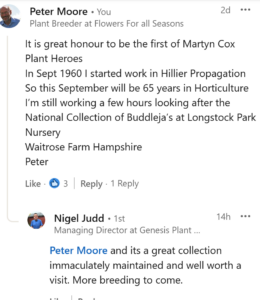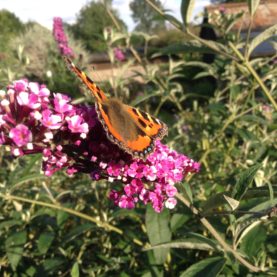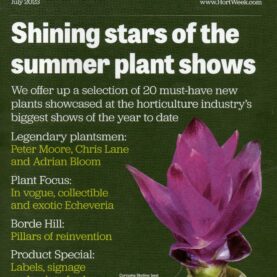HortWeek February 2025
Choisya ‘Aztec Pearl’
One of the best-known shrubs of modern times almost didn’t get its chance to add some dazzle to gardens with its striking evergreen foliage and fragrant, pink-tinged white flowers. It was the summer of 1982 and, at Hillier Nurseries in Hampshire, two precious seedlings of an unnamed Choisya were given their final watering of the working week before most of the staff in the propagation department downed tools for the weekend.
“I arrived back at work on Monday and discovered the seedlings were on their last legs,” recounts plant breeder Peter Moore, who was responsible for the seeds and cuttings that arrived at the nursery from collectors and botanical gardens around the world. “It had been very hot that weekend and the person on watering duty had missed them out. It was a long time ago, but I seem to remember I swore quite a bit.”
Seedlings revived
Fortunately, Moore was able to revive the flagging Choisya seedlings, but he decided not to risk a repeat mishap by taking them home and planting in his own garden for safekeeping. It was a wise move on his part because the eventually named Choisya × dewitteana ‘Aztec Pearl’ was launched to great fanfare at the end of the decade and went on to become a familiar sight in gardens around the country.
Forming a rounded, 1.5m-high by 1.5m-wide mound of evergreen foliage, this variety of Mexican orange blossom is instantly recognisable for its narrow, shiny, dark-green leaflets. In late spring and early summer, it is smothered with clusters of pink buds that open into scented white flowers, followed by a second flush in late summer and early autumn. In mild places, it can even produce flowers in winter.
Due to its size and form, ‘Aztec Pearl’ tends to be seen towards the middle or back of mixed beds and borders. The shrub is completely hardy — although it is best grown in a sheltered spot to prevent wind scorch — and fairly drought tolerant once established. It produces flowers freely in a sunny position, but can handle semi-shade, although flowering will be reduced.
The origins of ‘Aztec Pearl’ can be traced back to 1978, when Moore received a box of seeds from Sally Walker, an English horticulturist who emigrated to the USA in the 1960s and set up a company called Southwestern Native Seeds in Tucson, Arizona. Among the consignment were some seeds of Choisya dumosa var. arizonica, a wild variety collected by Walker in Arizona.
Two years after being sown, the resultant young plants were bearing flowers, and Moore decided to see whether he could raise a new plant through cross-pollination. One lunchtime, under the watchful eye of legendary Hillier propagator Peter Dummer, he removed the stamens from the aforementioned plants with a sharp Tina knife and applied pollen from the flowers of Choisya ternata.
“In The Hillier Manual of Trees & Shrubs from 1977, Choisya ternata was the only Choisya listed, so I thought I’d try and cross the two species,” says Peter. “Choisya dumosa var. arizonica has very glaucous narrow leaves and those of Choisya ternata are wider and trifoliate, so there was every chance that if the hybrid was successful it would be totally different to its parents.”
Distinctly different
Moore was correct and by 1984 he had two distinctly different looking Choisya growing in pots in his back garden. Peter Dummer and plantsman Roy Lancaster came to inspect the plants and selected one that Dummer eventually named ‘Aztec Pearl’. The other seedling did not have quite as good a habit and Moore gave it to his brother.
Five years later and Moore’s baby was given its public debut at the RHS Chelsea Flower Show, where it took pride of place on the Hillier Nurseries stand. It received positive write-ups in the gardening press and featured on the BBC’s show coverage. A drawing of the plant was used to illustrate The Times’ preview of the show, in which it was described as “a pretty evergreen shrub with scented flowers”.
It was an instant hit and within a few years ‘Aztec Pearl’ was available at every garden centre in the UK. Moore claims that by the early 1990s it was one of the top-selling evergreen shrubs in the EU. Steve Reed, production director for the container division at Wyevale Nurseries, was in charge of propagation at the nursery at the time. He estimates that it sold around 10,000 units to retailers and garden centres, with more plants picked up by amenity customers.
After his success with ‘Aztec Pearl’, Moore caught the bug for breeding Choisya and has introduced five others, including C. × dewitteana Apple Blossom and C. × dewitteana Goldfingers, a golden-leaved form that took 10 years to perfect. However, perhaps his most significant is C. × dewitteana White Dazzler, a super compact, free-flowering variety launched in 2009 that is hardy down to about -20°C and boasts the RHS Award of Garden Merit.
Today, some 36 years after it was launched, ‘Aztec Pearl’ is still considered a fine shrub by
gardeners, but it has been superseded in sales by C. × dewitteana White Dazzler. Moore suggests this is because commercial nurseries find it difficult to produce bushy, flowering specimens of ‘Aztec Pearl’ for garden centres.
At the garden centre attached to RHS Garden Wisley in Surrey, plant buyer Tom Cardrick calculates that C. × dewitteana White Dazzler outstrips ‘Aztec Pearl’ by three-to-one in sales, while Charles Carr, head of wholesale nurseries for Hillier, says it no longer sells ‘Aztec Pearl’ at all.
“At the time it was ground-breaking, but it has been overtaken by White Dazzler,” he explains. “It’s our third best-selling shrub and ticks so many boxes — it’s evergreen, compact, floriferous and easy to prune. All in all, it’s one of my desert island plants.”
Fact file
-
- Name: Choisya × dewitteana ‘Aztec Pearl’
- Introduced: 1989
- Breeder: Peter Moore
- Nursery: Hillier Nurseries
Martyn Cox is a garden writer, television presenter and speaker
Comments from friends
Hi Peter
I have just picked up your message and read all you have to say regarding your work as a propagator and plant breeder and I congratulate you for all that you have contributed to the world of horticulture during your long career. It is right that YOU should be writing more about your life of plants and you have a huge audience waiting to hear about it.I wish you the very best of success.
I look forward to hearing more about your work and look forward to seeing you next time I visit Longstock.
Happy Days,
Roy Lancaster Thurs 20th Feb
Dear Peter
How good to hear from you Susan is up with us at present and we were only talking about you earlier what an amazing coincidence. Many congratulations on the piece on you in Hort Week you are a real celebrity and deservedly so. Pete D. would be so pleased to think how he inspired
Brian Humphrey Production Director Hilliers in 1965- 1988
Hi Peter, how interesting. In fact, I passed a Choisya AP today that actually had a few blooms! I feel as if I am walking with a real celebrity! Linda
Excellent article, well done yet again for raising such great plants and also getting the recognition for doing so. Gareth
Hi Peter, very interesting bit of plant breeding history, you must have been thrilled at the time when it was big news in the gardening world. Also still standing the test of time which is incredible
Julian Bramley
At the time it was ground-breaking, but it has been overtaken by White Dazzler,” he explains. “It’s our third best-selling shrub and ticks so many boxes — it’s evergreen, compact, floriferous and easy to prune. All in all, it’s one of my desert island plants.”
Charles Carr Director Wholesale Hillier Nurseries
I always knew you were famous Peter. When will you be doing an autograph signing? Ian




